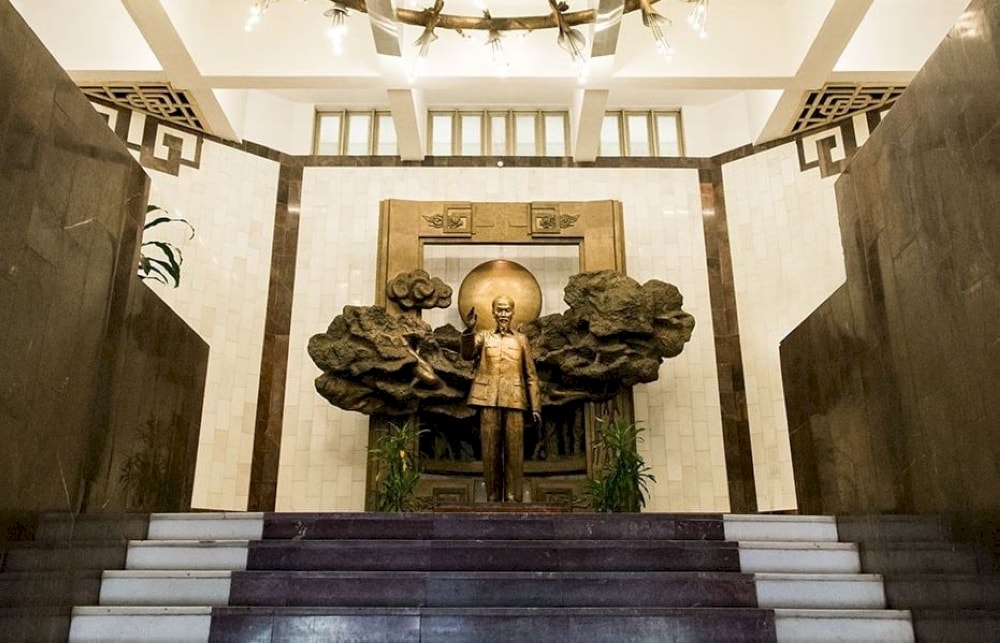
The Ho Chi Minh Mausoleum is one of Hanoi’s most iconic landmarks, attracting thousands of visitors every year. More than just a sightseeing stop, the Mausoleum represents Vietnam’s complex modern history and the enduring legacy of its most famous leader. If you’re planning a trip to Hanoi and want to understand Vietnam beyond just its street food and nightlife, then visiting the Ho Chi Minh Mausoleum should be on your list.
The Ho Chi Minh Mausoleum was constructed between 1973 and 1975 after the death of President Ho Chi Minh, known affectionately by locals as “Uncle Ho.” Despite his personal wish to be cremated, the government decided to preserve his body to allow future generations to visit and pay their respects.
[caption id="" align="alignnone" width="1000"] Ho Chi Minh Mausoleum: A priceless work of Vietnamese people[/caption]
Ho Chi Minh Mausoleum: A priceless work of Vietnamese people[/caption]
It stands in Ba Dinh Square, the same place where Ho Chi Minh read Vietnam’s Declaration of Independence in 1945. The structure serves as both a political and cultural site, and for many Vietnamese citizens, it’s a place of deep emotional significance.
The design of the Ho Chi Minh Mausoleum is heavily influenced by Soviet architecture but adapted with Vietnamese elements. The building stands 21.6 meters tall and features grey granite on the outside and red marble interiors. It’s intentionally somber, built to reflect respect rather than grandeur. Around the Mausoleum, you’ll find neatly trimmed gardens and military guards standing in perfect silence.

The inscription above the entrance simply reads “Chủ tịch Hồ Chí Minh” (President Ho Chi Minh), keeping the focus on the man inside, not the monument itself.
The complex is more than just the tomb. A visit here gives you access to several nearby landmarks that were part of Ho Chi Minh’s life:
The Stilt House: A simple wooden house where Ho Chi Minh lived and worked. It’s surrounded by a tranquil pond and garden.
Presidential Palace: Built by the French during the colonial period, this yellow neoclassical building was offered to Ho Chi Minh, but he declined to live in it.
Ho Chi Minh Museum: An abstract collection of documents and art dedicated to his legacy.
One Pillar Pagoda: A small Buddhist temple built on a single stone pillar, just steps away from the main building.

When you enter the Ho Chi Minh Mausoleum, expect complete silence. Visitors walk in a single file through a cooled chamber where Ho Chi Minh’s embalmed body lies in a glass case. The visit takes only a few minutes, but the atmosphere is heavy with symbolism. Guards in white uniforms enforce strict rules: no photos, no talking, no large bags, and no phones.
Dress modestly. Shoulders and knees should be covered. If you’re wearing shorts or a tank top, you might be turned away or offered temporary clothing at the gate.
The Ho Chi Minh Mausoleum is open Tuesday to Thursday and on weekends, but only in the mornings.
Summer: 7:30 AM – 10:30 AM
Winter: 8:00 AM – 11:00 AM
It closes annually for maintenance, usually between September and November, so check ahead before you go.
Arrive early: By 7:00 AM, especially on weekends and holidays, the queue can already be long.
No filming or photos: Security is tighter than at many airports.
Use a guided tour if you want deeper context, especially for the museum and Presidential Palace.
Visit nearby sites after: Combine the Mausoleum with the Temple of Literature or West Lake for a full day out.
The Ho Chi Minh Mausoleum is about 15 minutes by Grab or taxi from Quiri Hostel Hanoi, located at 25 Hang Luoc, Hoan Kiem. You can also walk there in about 25–30 minutes if you want to enjoy Hanoi’s Old Quarter and French Quarter along the way.
Start your day early, grab the free breakfast at Quiri Hostel, and head over before the crowds arrive. You can leave your bigger bags at the hostel and carry only a small daypac